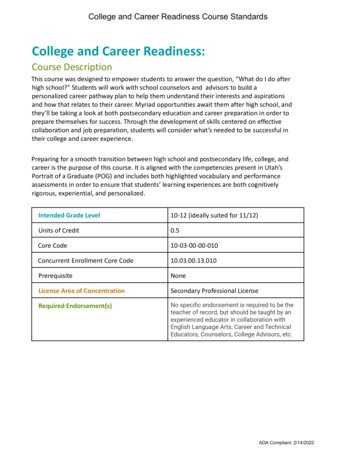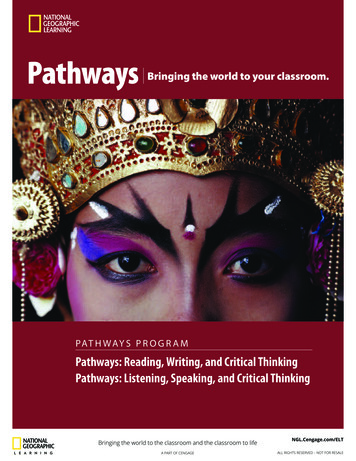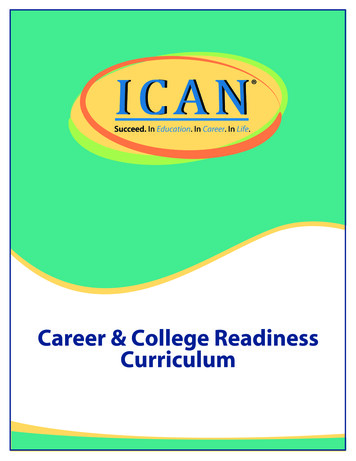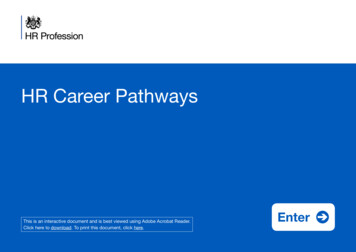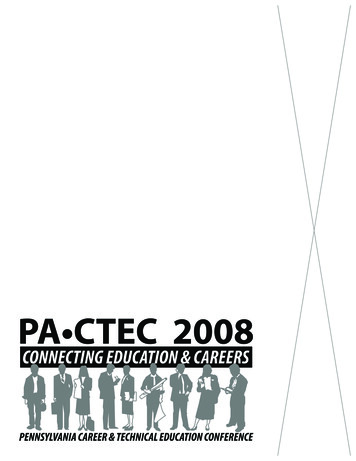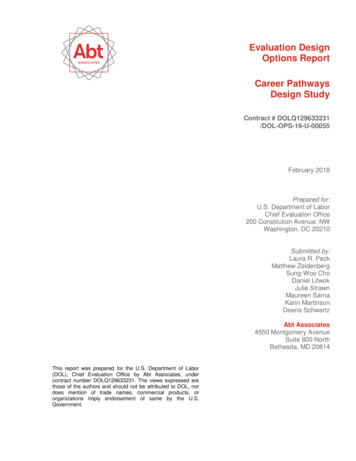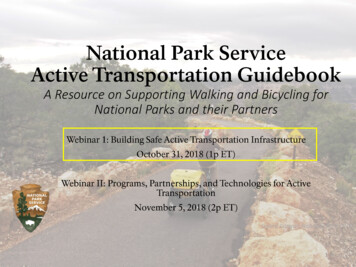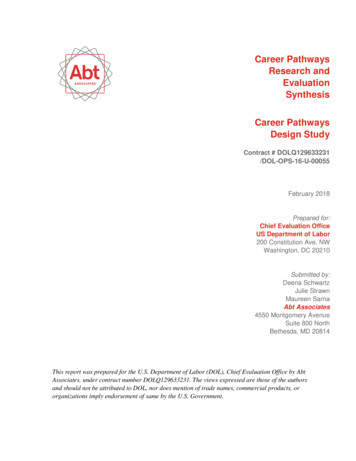
Transcription
Career PathwaysResearch andEvaluationSynthesisCareer PathwaysDesign StudyContract # DOLQ129633231/DOL-OPS-16-U-00055February 2018Prepared for:Chief Evaluation OfficeUS Department of Labor200 Constitution Ave, NWWashington, DC 20210Submitted by:Deena SchwartzJulie StrawnMaureen SarnaAbt Associates4550 Montgomery AvenueSuite 800 NorthBethesda, MD 20814This report was prepared for the U.S. Department of Labor (DOL), Chief Evaluation Office by AbtAssociates, under contract number DOLQ129633231. The views expressed are those of the authorsand should not be attributed to DOL, nor does mention of trade names, commercial products, ororganizations imply endorsement of same by the U.S. Government.
CONTENTSExecutive Summary . iii1.Introduction . 11.11.22.1.1.1Studies Included (and Excluded) . 21.1.2Categories Highlighted . 2Approach to Identifying Studies . 3Synthesis of Career Pathways Research and Evaluations . 52.12.22.33.Research and Evaluation Studies Included in This Synthesis . 2What Kinds of Career Pathways Initiatives Have Been Studied? . 52.1.1Initiatives and Key Services . 52.1.2Target Population and Demographics Served . 62.1.3Sector and Occupations . 92.1.4Lead Organizations . 10What Evaluation Methods and Research Designs Have Been Used?. 112.2.1Type of Study . 112.2.2Data Sources . 122.2.3Funders of Career Pathways Studies . 13What Questions Have Been or Will Be Answered by Completed and OngoingResearch?. 142.3.1Research Questions . 142.3.2Current Status and Timing of Results. 17Implications for Future Research . 263.1Career Pathways Evidence to Date . 263.2Ongoing Career Pathways Research. 273.3Questions for Future Research . 283.4Next Steps . 30References . 31Abt AssociatesCareer Pathways Research and Evaluation Synthesis pg. i
CONTENTSList of ExhibitsExhibit 2.1.Summary of Career Pathways Studies . 6Exhibit 2.2.Target Populations in Career Pathways Studies . 7Exhibit 2.3.Demographics of Population Served in Career Pathways Studies . 8Exhibit 2.4.Sectors/Occupational Clusters Targeted in Career Pathways Studies . 9Exhibit 2.5.Healthcare Occupations Targeted in Career Pathways Studies . 10Exhibit 2.6.Lead Organizations in Career Pathways Studies . 11Exhibit 2.7.Study Type Used in Career Pathways Studies . 12Exhibit 2.8.Data Sources Used in Career Pathways Studies . 13Exhibit 2.9.Funders of Career Pathways Studies . 13Exhibit 2.10.Explicit Focus on Career Pathways of Research Questions in Studies . 16Exhibit 2.11.Outcomes Measured in Career Pathways Studies, by Study Type . 17Exhibit 2.12.Career Pathways Studies with Recent Results or Upcoming Results Expected. 19Exhibit 2.13.Summary of Published Impact Findings in Career Pathways Studies (QuasiExperimental and Random Assignment) . 21Abt AssociatesCareer Pathways Research and Evaluation Synthesis pg. ii
EXECUTIVE SUMMARYExecutive SummaryCareer pathways approaches to workforce development offer articulated education and training stepsbetween occupations in an industry sector, combined with support services, to enable individuals toenter and exit at various levels and to advance over time to higher skills, recognized credentials, andbetter jobs with higher pay. The U.S. Department of Labor (DOL), Chief Evaluation Officecontracted with Abt Associates to conduct the Career Pathways Design Study, to developevaluation design options that could address critical gaps in knowledge related to the approach,implementation, and success of career pathways strategies generally, and in early care and education(ECE) specifically. To inform thinking about evaluation design options, Abt produced reports on (1)research and evaluation relevant to career pathways approaches, (2) the implementation of existingand past career pathways initiatives, and (3) the potential for career pathways approaches in early careand education.This report is the first of these publications and provides a high-level synthesis of careerpathways research and evaluation. The primary purpose of this report is to support development ofevaluation design options. With that in mind, our review focuses primarily on the type, scope, andsetting of research that either has been completed or is ongoing; on which questions have been asked;and on areas for further research. We also highlight some major research findings, though that is notthe main focus of this report. For this synthesis, we identified 52 studies, both complete and ongoing(as of February 2017, when we conducted the analysis), that focus on career pathways approaches foradults (including young adults, but excluding high school students) and include occupationaltraining. 1We found: 52 studies, of which 23 were complete at the time of our analysis.26 studies will produce additional results by 2021; at least 10 new impact reports will becompleted over the next year alone.In 39 studies, at least one site offered multiple steps of career pathways training; in only 12studies was this true of every site.Of the career pathways efforts reported in the 52 studies: 1232 focused on the program level (62 percent); one on system-level change; and 19 on both (37percent). 2We did not include initiatives focused solely on 4-year degrees or solely on transfer to 4-year degree programs.The synthesis also categorized studies as examining either system-level or program-level initiatives, or both, to theextent that it was possible to determine this from available information. For purposes of this report’s categorization ofefforts, we defined “system level” as addressing at least in part the six career pathways systems elements to reducebarriers and create opportunities for individuals to advance within specific fields described by DOL in its CareerPathways Toolkit. “Program-level” efforts we defined as specified in WIOA, as initiatives seeking to provideindividualized training and supports that (1) align with the skill demands of the state and local economy; (2) prepareindividuals to be successful in a range of secondary and postsecondary education options; (3) include academic andcareer counseling, as well as non-academic supports; (4) provide, as appropriate, concurrent and accelerated programdesigns, and (5) help individuals to enter or advance within a specific occupation or occupational cluster. However, itAbt AssociatesCareer Pathways Research and Evaluation Synthesis pg. iii
EXECUTIVE SUMMARY 23 targeted low-income individuals or those living in poverty (44 percent), followed by 14targeting low-skilled individuals (27 percent).Typical participants were high school graduates in their late 20s or 30s and more likely to befemale than male.3 Few studies (five) included substantial percentages (more than 25 percent) ofHispanics. In 12 studies, more than 25 percent of participants were Black or African American.Healthcare was by far the most common sector (39 studies), followed by manufacturing (22studies), information technology (18 studies), and business (14 studies). 4Most studies (22) included efforts that offered training in multiple sectors; of the 17 single-sectorones, 14 focused on healthcare.Community colleges most commonly led career pathways efforts (34 studies), followed by nonprofit organizations (20 studies), workforce development boards (16 studies), and othereducational institutions (16 studies).Evaluation Methods and Research Design Most studies (40) used several different methodologies.More studies (20) used random assignment methodologies than used quasi-experimental or nonexperimental methodologies. Almost two thirds (13) of the random assignment studies areongoing.More than one quarter (14) of the studies included some examination of costs.Only two studies included systems change analysis, but many others included implementationstudies of system-level initiatives.More than two thirds (37) of the studies were funded at least in part by the federal government,either directly by federal agencies or as part of required third-party evaluations of federal grants.Foundations funded 13 of the studies.Research Questions and Findings 345About one third of studies (18) included research questions that either specifically mentionedcareer pathways in a question or included questions about an initiative that was explicitlydescribed as a career pathways approach.Of the 42 studies for which we identified outcomes, 38 included at least one employmentoutcome and 29 included at least one education outcome.As of February 2017, impact findings have been published for four quasi-experimental and eightrandom assignment studies.5 All but one of those studies is complete.should be noted that we have also included some seminal studies of programs focused on key components of careerpathways, though the programs themselves did not define themselves as career pathways programs.Participants may be more likely to be female in part because so many studies were of the healthcare sector, which tendsto employ more women than men.We listed sectors as they were described by research studies or the sites included in studies. For example, “business”frequently included “business administration and management”, “finance and business”, and “business.” Trainingprograms categorized as being in the business sector often include offerings in areas such as accounting or officeadministration.Impact studies use methods that allow researchers to determine whether outcomes are attributable to the program. Thisis in contrast to non-experimental studies, which measure and describe the outcomes achieved by participants, but doAbt AssociatesCareer Pathways Research and Evaluation Synthesis pg. iv
EXECUTIVE SUMMARY Most of these published impact findings have short- ( 1-2 years) and medium- (3-4 years) termfollow-up periods. Just two studies to date have reported impact findings for long-term outcomes(5 years or longer). The follow-up periods ranged from two semesters to five years for therandom assignment studies, and one academic quarter to nine years for the quasi-experimentalstudies.Nine of these impact studies examined earnings. Three found statistically significant positiveresults, five found mixed results, and one found mostly negative results. 6Ten of these impact studies examined educational outcomes. Seven found statistically significantpositive results, one found mixed results, and two found mostly negative results.Of the eight random assignment studies reporting impacts, only one included at least one site thatoffered multiple steps of training. We chose to highlight multiple steps of training as a proxy forunderstanding the extent to which sites in a study focused on career advancement, arguably themost distinctive feature of career pathways. 7Looking across all of the studies we examined, researchers found that implementing a model asintended often proved challenging. Sites varied considerably in the populations targeted andserved, targeted sectors and occupations, and the extent to which a given model was implementedas planned.Implications for Future Research 67As noted above, few of the reported impact findings to date are from studies of career pathwaysinitiatives offering multiple steps of training. In addition, most findings are from studies withshort- or medium-term follow-up periods, making it difficult to measure pathway progression.Research that is currently underway (referred to in this report as “ongoing”) will add substantiallyto the evidence base, contributing additional evidence in the following ways— Employment and earnings impacts particularly through random assignment designs.Longer-term outcomes and impacts. Descriptive information about career pathways approaches and their implementation. More evaluations of initiatives that have a strong career pathways focus (as indicated bytheir including sites that offer multiple steps of training). Analyses of program costs. The effectiveness of specific components within a career pathways approach. Systems change initiatives.Current ongoing studies largely do not address a number of topics, such as: Information (e.g., effectiveness, implementation, systems change, etc.) about careerpathways programs and approaches in sectors other than healthcare, manufacturing, andinformation technology.not use a comparison group which would allow one to understand what would have happened in the absence of theprogram and therefore determine if the program caused the outcomes found.Mixed results include two or more of the following: statistically significant positive results, statistically significantnegative results, or non-statistically significant positive or negative results.By step, we mean successively higher skilled steps of training along a career pathway, such as entry-level, mid-leveland advanced training, which correspond to specific, increasingly better paid jobs.Abt AssociatesCareer Pathways Research and Evaluation Synthesis pg. v
EXECUTIVE SUMMARY Implementation and effectiveness of career pathways approaches for groups typically notwell represented in career pathways studies, including youth, Hispanics, and individualswith specific employment barriers such as no high school diploma, very low skills (lessthan eighth grade), limited English proficiency, criminal records, or disabilities.The relative effectiveness of particular components within a career pathways bundle ofbenefits and services.The role the public workforce system can and should play in supporting career pathways ascompared with community colleges, nonprofit organizations, and other entities.The implementation of career pathways at scale (in terms, for example, of numbers ofpeople served, regional or national scope, or penetration of a particular sector’s labormarket).The return on investment to career pathways for individuals, the public, and employers.This synthesis of career pathways research and evaluation is one step in this project. The other twodeliverables synthesize how different career pathways programs and systems change initiatives aredefining and implementing career pathways, and examine the potential for career pathwaysapproaches in the early care and education sector. Together, these three documents will inform thestudy’s final deliverable—the career pathways evaluation design options report.Abt AssociatesCareer Pathways Research and Evaluation Synthesis pg. vi
INTRODUCTION1.IntroductionCareer pathways approaches to workforce development offer articulated education and training stepsbetween occupations in an industry sector, combined with support services, to enable individuals toenter and exit at various levels and to advance over time to higher skills, recognized credentials, andbetter jobs with higher pay. Each step on a career pathway is designed explicitly to prepareindividuals to progress to the next level of employment and/or education. Career pathways strategiestarget jobs in industries of importance to local and regional economies and build strong relationshipswith employers. 8The career pathways framework evolved over the last decade as a response to emerging evidence onlabor market changes and on the limits of previous employment and training strategies. In the labormarket, individuals with a high school education or less experienced stagnating wages and highunemployment over the last 30 years, whereas those with postsecondary credentials experiencedeconomic gains (Autor 2015; Carnevale, Jayasundera, and Gulish 2016). In the workforcedevelopment field, researchers studying long-term outcomes found that the two most commonemployment strategies for low-income adults—quick job placement or stand-alone basic skillsinstruction—neither increased employment and earnings over the long run nor helped participantsescape poverty (Hendra and Hamilton 2015). By emphasizing postsecondary job skills, careerpathways approaches seek to respond to these labor market changes and to deliver larger and longerlasting results than previous employment and training strategies. The career pathways framework alsoseeks to incorporate promising features of recent workforce development innovations, such astargeting industry sectors and integrating basic education with job training (Werner et al. 2013). Inaddition, the career pathways approach involves providing a range of supports to students includingadvising, financial assistance, and connections to the labor market and jobs.The rapid rise of career pathways nationally, including an emphasis on them in the WorkforceInnovation and Opportunity Act (WIOA), creates a critical need for sound evidence that showswhat works well, why, under what circumstances and for whom. The WIOA legislation requiresthe U.S. Department of Labor (DOL) to “conduct a multistate study to develop, implement, and buildupon career advancement models and practices for low-wage health care providers or providers ofearly education and child care” (29 U.S. Code § 3224(b)(4)(I)).In response, the Chief Evaluation Office (CEO) at DOL funded the Career Pathways Design Studyand contracted with Abt Associates to develop evaluation design options that could address criticalgaps in knowledge related to the approach, implementation, and success of career pathways strategiesgenerally, and in early care and education specifically (given the scarcity of information on it relativeto healthcare). To meet these goals, Abt has developed three reports on the following topics: (1)research and evaluation relevant to career pathways approaches, (2) the implementation of existingand past career pathways initiatives, and (3) the potential for career pathways approaches in early careand education.8For a review of how career pathways are defined in practice at the program and system levels, see the Career PathwaysImplementation Synthesis report from this project (Sarna and Strawn, 2017).Abt AssociatesCareer Pathways Research and Evaluation Synthesis pg. 1
INTRODUCTIONThis report provides one of the deliverables for the project—a synthesis of career pathwaysresearch and evaluation. This synthesis describes the range of completed and ongoing research incareer pathways, and summarizes what questions have or will be answered by that research, whatunanswered questions remain, and directions for future research. The Career Pathways Research andEvaluation Matrix (Appendix A) summarizes the studies identified. The information in this report andthe accompanying matrix is current as of February 2017.The two other deliverables for the Career Pathways Design Study synthesize how different programsand systems change initiatives are defining and implementing career pathways approaches, andexamine the potential for career pathways approaches in the early care and education sector.Together, the three documents will inform the study’s final deliverable—the career pathwaysevaluation design options report. That final report will examine four groups of research questions andwill describe possible research approaches and data sources for addressing them.1.1Research and Evaluation Studies Included in This SynthesisThe primary purpose of this report is to inform the evaluation design options. With that in mind, ourreview focuses primarily on the type, scope, and setting of research that either has been completed oris ongoing; on which questions have been asked; and on areas for further research. We also highlightsome major research findings, though that is not the main focus of this report.1.1.1Studies Included (and Excluded)We included studies of approaches that:(1) focus on adults (including young adults, but excluding high school students);(2) include occupational training; and(3) describe themselves as involving career pathways, or which include at least some keyelement(s) of the pathways approach.Because DOL was interested in understanding how the workforce field itself defines and implementscareer pathways approaches, we cast a broad net in deciding which studies to include, incorporatinginto the matrix and our analysis any studies that included initiatives that described themselves asinvolving career pathways as well as others that had at least some elements of career pathwaysapproaches, whether or not they met any particular definition of a career pathways model. 9 We alsoincluded several training efforts that were not explicitly career pathways approaches—in some casespredating the concept—where there were major studies of initiatives representing core elements of acareer pathways approach, such as sector partnerships or integrated basic education and training.1.1.2Categories HighlightedWe highlight throughout the Matrix and in selected tables of this report those initiatives that includemore than one step of education or training in a formal career pathway or feed from one step oftraining into a closely linked, specific next step(s) and take active steps to help participants enroll inthat training (e.g., from Medical Assisting to Licensed Practical Nursing to Registered Nursing, or9That is to say, a report did not need to label itself as being about the career pathways approach, but if it involvedcontent that was indeed related, then we included it. We also included an analysis of various definitions of the careerpathways approach in the Implementation Synthesis report, as described below.Abt AssociatesCareer Pathways Research and Evaluation Synthesis pg. 2
INTRODUCTIONforklift driver to shipping/receiving clerk to logistics technician). These we distinguish on the Matrixby the column labeled “Multiple steps of training.” We chose this proxy because it appears to be anobjective characteristic that helps separate out training approaches that actively promote educationaladvancement tied to higher levels of jobs, versus more traditional programs that provide only a singledose of job training, even if they describe themselves as implementing a career pathways model.Because these efforts with multiple steps of training may be of particular interest to DOL, some tablesbelow show both the characteristics of the studies overall and the characteristics of only those studiesthat include multiple steps of training.The synthesis also categorizes studies as examining either system-level or program-level initiatives, orboth, to the extent that it was possible to determine this from available information. Policymakers andthe workforce development field define “career pathways” in a variety of ways, and theimplementation synthesis report discusses the range of definitions in use. A designation as systemlevel or program-level is distinguished in the Matrix in the column labeled “Description of Initiative.”For purposes of this report’s categorization of efforts, we define “system-level” as addressing the sixcareer pathways systems elements to reduce barriers and create opportunities for individuals toadvance within specific fields described by DOL in its Career Pathways Toolkit. 10 “Program-level”efforts we define as specified in WIOA, as initiatives seeking to provide individualized training andsupports that (1) align with the skill demands of the state and local economy; (2) prepare individualsto be successful in a range of secondary and postsecondary education options; (3) include academicand career counseling, as well as non-academic supports; (4) provide, as appropriate, concurrent andaccelerated program designs; and (5) help individuals to enter or advance within a specific occupationor occupational cluster. 11 Many of the initiatives studied only included some of the elements in thesesystem-level and program-level definitions.1.2Approach to Identifying StudiesTo identify the studies included in the synthesis, we began with those identified for earlier researchreviews as part of a previous DOL project. We then conducted a broader scan, reviewing relevantorganization and project websites and publications, to identify additional career pathways initiatives,to include both in this review of research and in the related scans of career pathways implementationand early care and education career pathways approaches (the two other project deliverables).1011The elements are to (1) build cross-agency partnerships and clarify roles, (2) identify industry sectors and engageemployers, (3) design education and training programs, (4) identify funding needs and sources, (5) align policies andprograms, and (6) measure systems change and f/career pathways toolkit.pdf)The full definition of “career pathway” included in WIOA is “a combination of rigorous and high-quality education,training, and other services that— (A) aligns with the skill needs of industries in the economy of the State or regionaleconomy involved; (B) prepares an individual to be successful in any of a full range of secondary or postsecondaryeducation options; (C) includes counseling to support an individual in achieving the individual’s education and careergoals; (D) includes, as appropriate, education offered concurrently with and in the same context as workforcepreparation activities and training for a specific occupation or occupational cluster; (E) organizes education, training,and other services to meet the particular needs of an individual in a manner that accelerates the educational and careeradvancement of the individual to the extent practicable; (F) enables an individual to attain a secondary school diplomaor its recognized equivalent, and at least 1 recognized postsecondary credential; and (G) helps an individual enter oradvance within a specific occupation or occupational cluster.”Abt AssociatesCareer Pathways Research and Evaluation Synthesis pg. 3
INTRODUCTIONThe scan was supplemented with input from researchers on the study team, DOL staff, and otherfederal agency staff involved in research on career pathways approaches. Included in this scan of thefield were a number of large current and recent career pathways and related evaluation projectssponsored by federal evaluation offices, including: Pathways for Advancing Careers and Education (PACE),Evaluations of Health Profession Opportunity Grants (HPOG),The Green Jobs and Health Care Impact Evaluation,Evaluation of H-1B Ready to Work Partnership Grants,Workforce Innovation Fund (WIF) Evaluations,Trade Adjustment Assistance Community College and Career Training (TAACCCT) grantevaluations, andTAACCCT Community College Consortium for Biosciences Credentials grant evaluations.After identifying studies in the initial scan and outreach, whenever possible we reviewed publishedfinal reports to complete the Matrix. When the information was not available from these reports, wedrew from evaluation design reports, interim reports, and project and evaluator websites. In somecases, we inquired directly of researchers or others familiar with the study. Because many of thestudies in the Matrix are ongoing, data sometimes were unavailable or not applicable (this is noted inthe Matrix). The sources used for each study are included in Appendix B.The unit of analysis for this report is research or evaluation study, as the purpose is to synthesizewhat kinds of research have been or will be conducted on career pathways. Large, multi-site studies(such as PACE) are counted as a single study if they are or will be conducted under an umbrellaevaluation with uniform research questions and eva
Career pathways approaches to workforce development offer articulated education and training steps between occupations in an industry sector, combined with support services, to enable individuals to . could address critical gaps in knowledge related to the approach, implementation, and success of career pathways strategies generally, and in .
